
Safety cameras have become ubiquitous on commercial vehicles. From 360-degree all-round protection to vehicle CCTV, cameras have significantly reduced collisions and injuries, successfully protecting fleets, safeguarding drivers, and shielding vulnerable road users from harm.
The size of commercial vehicles means that vehicle blind spots are a major factor in collisions across all industries. Operator positions, bulky bodywork, and the absence of rear windows all contribute to restricting and limiting a driver's visibility. Installing cameras, either at the point of manufacturing or retrospectively, has proved to be invaluable in preventing collisions, protecting equipment from damage, and minimizing the associated financial costs and downtime.
The importance of commercial vehicle safety systems, including cameras, has become widely recognized across the world as a major contributor to the prevention of death and injury on roads and in workplaces. Indeed, Transport Canada stipulates that backup cameras are fitted as regulation to passenger cars, SUVs, light pickup trucks, and minivans.
While preventing deaths and injuries on the road and in the workplace is no doubt a number one priority for fleet operators, keeping equipment safe and maintaining fleet efficiency are also top of the agenda. Cameras with 360-degree capabilities that can be combined with vehicle CCTV are making a huge difference in helping to manage fleets, maintain safety and keep vehicles secure.
The introduction of high definition (HD) is enhancing these safety camera options.
"High definition cameras, such as Brigade's Backeye 360 HD BN360-300, are offering complete security and peace of mind for drivers and fleet managers by ensuring that blind spots are eliminated and acting as a reliable eye-witness in the event of an incident, false claim or theft," said Warren Di Marco, Brigade Electronics Canada CEO and vehicle safety expert. "HD provides better clarity with clearer, crisper images for drivers and operators, making the resulting footage invaluable in terms of both safety and security."
Research carried out by Brigade has proved that its vehicle CCTV has been effective in slashing personal injury claims and reducing insurance premiums. The survey of drivers, fleet managers, and other industry professionals found that 29 percent said personal injury claims had dropped, while 32 percent saw a reduction in insurance costs.
High definition versus standard definition vehicle CCTV
High definition means a high-resolution image will be displayed on a driver's monitor, providing clarity and detail, allowing them to see an object or person in a vehicle's blind spot with ease.
The difference between high definition and standard definition is the number of pixels contained in the displayed image. HD images have more pixels per square inch than standard definition. This means an HD system will show much finer details than standard definition systems. Typically, HD is referred to as 720p and above.
"At Brigade we recommend using analogue rather than digital HD cameras as they offer many benefits for commercial vehicles drivers," said Di Marco. "These include being able to transmit video over traditional cabling across distances as far as 1650 feet - plenty of cabling length for any commercial vehicle. Additionally, there is no video latency, so drivers will benefit from a true view of everything on the monitor."



